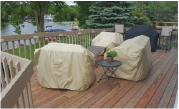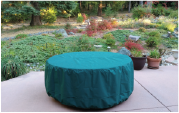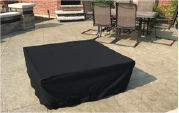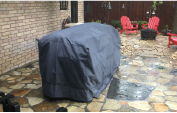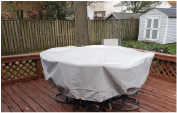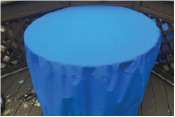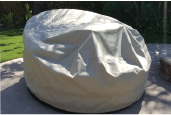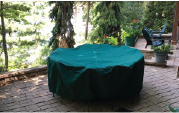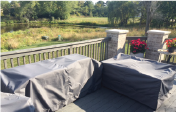
Finding the right outdoor furniture cover isn’t just about picking a size that looks close enough. Your furniture is covered by a cover that fits like a glove in all weather, seasons, rain, snow, sun, and wind, without wrapping, falling, or tearing. To achieve that perfect fit, understanding how to measure furniture is the most crucial step.
When you are ordering a custom-fit outdoor furniture cover or the standard size, proper measurements will be the difference between a snug, elegant look and a cover that slides off or traps water. In this blog, we will go through every step of taking the measurements for the furniture cover.
Why Accurate Measurements Matter
Consider a furniture cover, such as a custom suit. Too tight, it becomes like a strain on the seams; too loose, it becomes like wrinkles and folds, and appears like a mess. Most individuals would think that purchasing a slightly bigger cover is the safe choice, but this may, in fact, do more harm than good. A loose cover may pick up puddles of water or may blow away. Alternatively, a tight one can stretch the seams, and it can be hard to remove it or fix it.
Finding a cover that fits correctly and has adequate breathing room to move air is the ultimate goal. Your investment in durable outdoor furniture will be well worth it because your chairs, tables, and loungers will look brand new for many years if you take the right measures for your covers.
Step 1: Prepare Your Furniture
Make certain that your furniture is in its ordinary outdoor position before commencing to measure it. Unfold any cushions, folding tables, or recliners, and hold any detachable units (such as umbrella holes or headrests) in place if you want to cover them. If you tend to remove cushions before covering, remove them before making measurements; then the measurements will be indicative of the way your furniture will be when it is covered.
Step 2: The Three Core Measurements
Speaking of the way furniture should be measured to cover it, all you require are three simple measurements: width, depth, and height.
- Width: The term "width" is used to mean the distance between the outer edge and the opposite outer edge (or vice versa). In the case of a sofa or bench, the distance is measured between the outside of one armrest and the outside of the other. In the case of a table, the longest side is measured.
- Depth: Depth refers to the measurements from front to back. Measure to the back of the piece from the frontmost point (which is usually the front of the seat or armrest). In the case of curved or angled furniture, measure the longest part to be covered.
- Height: Height is calculated as the vertical distance that is downward, starting at the tallest point. In the case of chairs and sofas, this is usually from the top of the backrest to the floor. To measure tables, gauge along the edge of a table.
When your furniture does not have a regular shape, such as a chair with a high backrest and low arms, mark the highest and lowest points. Most individuals do not bother to do this, and they find themselves having a cover that is not as long as it is supposed to be on one side.
Step 3: Adjusting for Shape and Features
Various furniture items require a little bit of different ways of measurement. Let’s explore some common examples.
- Outdoor Chairs: In measuring outdoor chair covers, the arms should be measured in case they are bigger than the seat. Test the distance between the floor and the seat backrest top, and the depth from the backrest to the front of the seat. When you are sitting on a chair with rounded arms or a slanted back, never guess but go by the farthest extremities. It takes only an inch or two to make a difference in the way your cover covers you.
- Sofas and Loveseats: In the case of a sofa or loveseat, measure the total width of the sofa, including the arm-to-arm length, the depth of the cushion to the back, the amount of the cushion length to the backrest, and the distance from the floor to the top of the backrest of the sofa. You should also add any removable back cushions that are in higher positions than the frame so that your cover fits properly.
- Tables: To measure a table cover, it is always important to measure the table in the widest areas. Remember to add any handles, umbrella ends, or any other protruding edges. The round tables must be measured across the diameter, straight across the center.
- Sectionals and L-Shaped Sets: Sectionals require more patience. Measure each piece separately, noting how they connect. Alternatively, if you plan to cover the whole set under one large custom-fit outdoor furniture cover, measure the total footprint, width, depth, and height of the entire assembled arrangement.
Sectionals need more patience. Measure individually, and recognize the connection of the pieces. Alternatively, when you are going to cover the entire set with a single large custom-fit outdoor furnishing cover, measure the combined size, the width, the depth, and the height of the entire assembled setup.
Step 4: Add a Small Buffer
After obtaining the raw measurements, add to them a small buffer, typically 1 to 2 inches, to your width and depth. This allowance ensures the cover slides on without putting any strain on the seams. One should not add excessive space, which will cause the hanging and accumulation of water.
You may actually subtract half an inch to an inch from the height. Outer covers that are slightly raised above the ground also permit a better flow of air, which eliminates moisture and mildew. This very small hole prevents the cover from brushing dirt or causing a puddle at the bottom.
Step 5: Consider Design Details
Good covers do not simply involve rectangles of cloth. They have many drawstrings, straps, or elastic hems to hold them in place. Make sure that your selected cover has these, and in case it does, make sure you leave space in your calculations.
In case your furniture is adorned with decorative pieces such as scroll arms, rounded backs, or sticking knobs, consider it too. It is better to quantify by the farthest point of any design and not the main frame.

Step 6: Double-Check Everything
After recording all measurements, take a second (or third) pass. Measurement mistakes are common, especially when switching between inches and centimeters or measuring around uneven surfaces. Write down your dimensions clearly, labeling which number refers to width, depth, and height.
A simple trick: use masking tape to mark your measuring points on the furniture. This way, you ensure consistency when double-checking.
Once all the measurements have been recorded, do a second (or third) pass. Measurement errors are likely to be particularly problematic when changing between the inch and centimeter systems or in measurements of irregular surfaces. List your dimensions with labels that are clear and indicate the number that corresponds to the width, the depth, and the height.
One of the tricks: mark your measuring points on the furniture with masking tape. In this manner, you would have a form of consistency during the process of checking twice.
The Bottom Line
It may not be the most thrilling thing to do, but once you know how to measure your furniture, you are guaranteed long-term protection and style. A little care and attention will get you to a point of a cover that will appear as though it was created by a designer, since, in a way, it was created to suit you.
Measure carefully, record all dimensions, and place orders with a lot of confidence. Anyway, no perfect fit is just a stroke of luck; it is good maths and more preparation.

_1.png)
